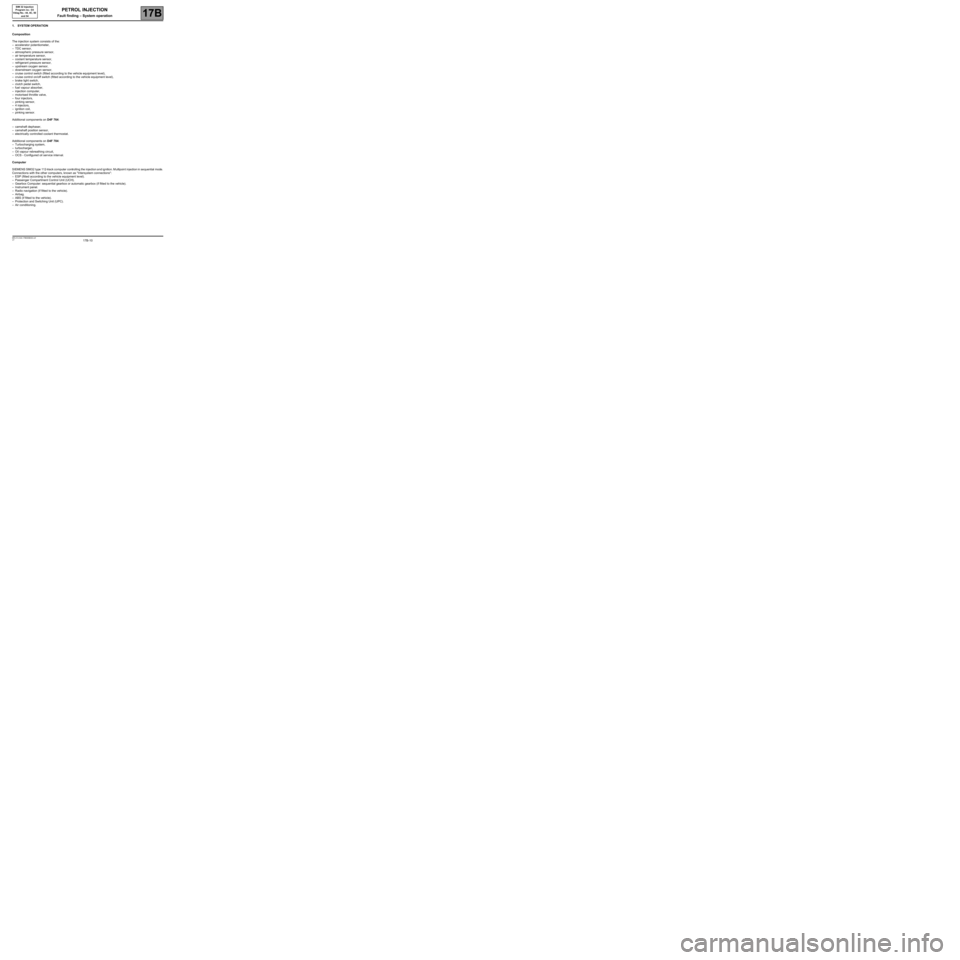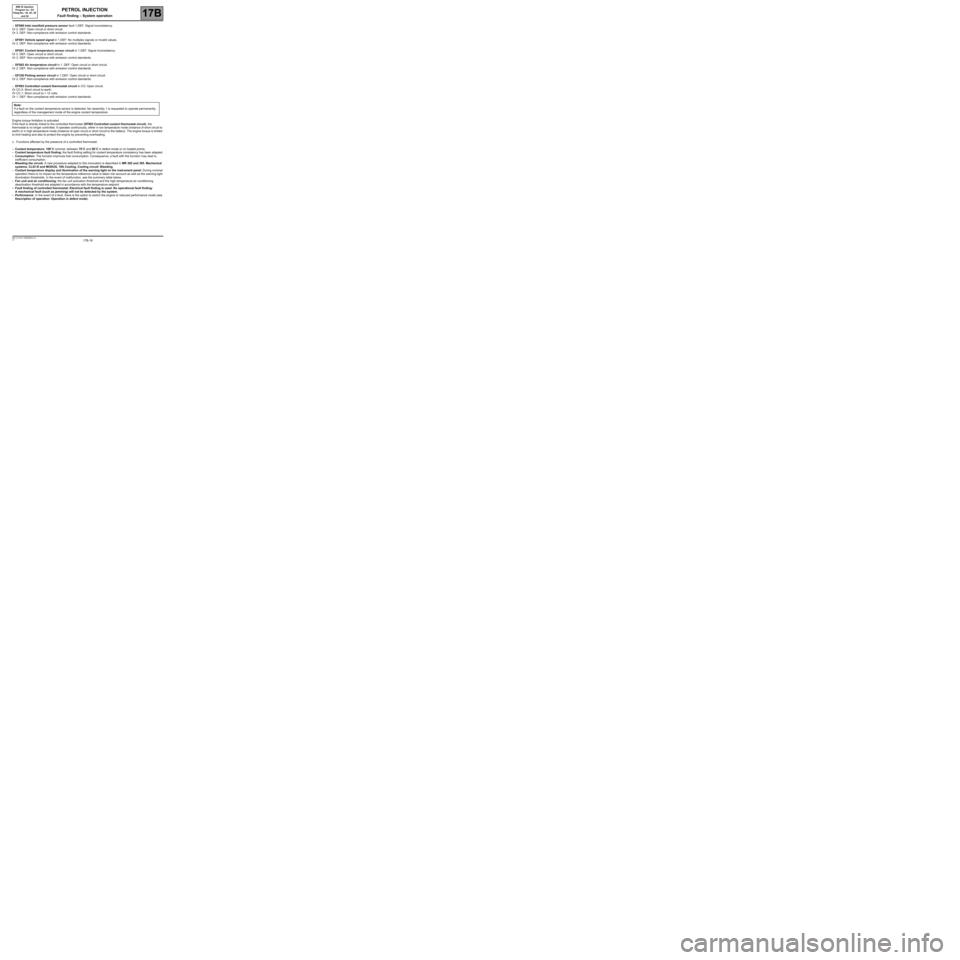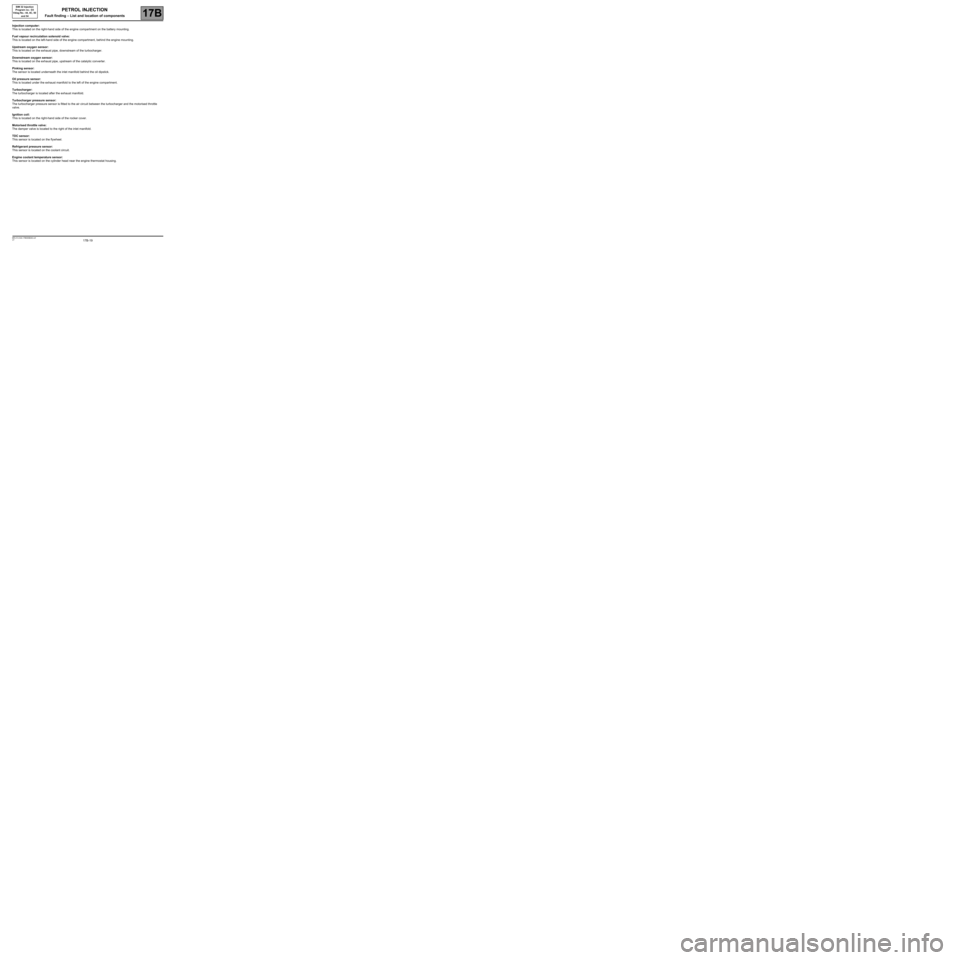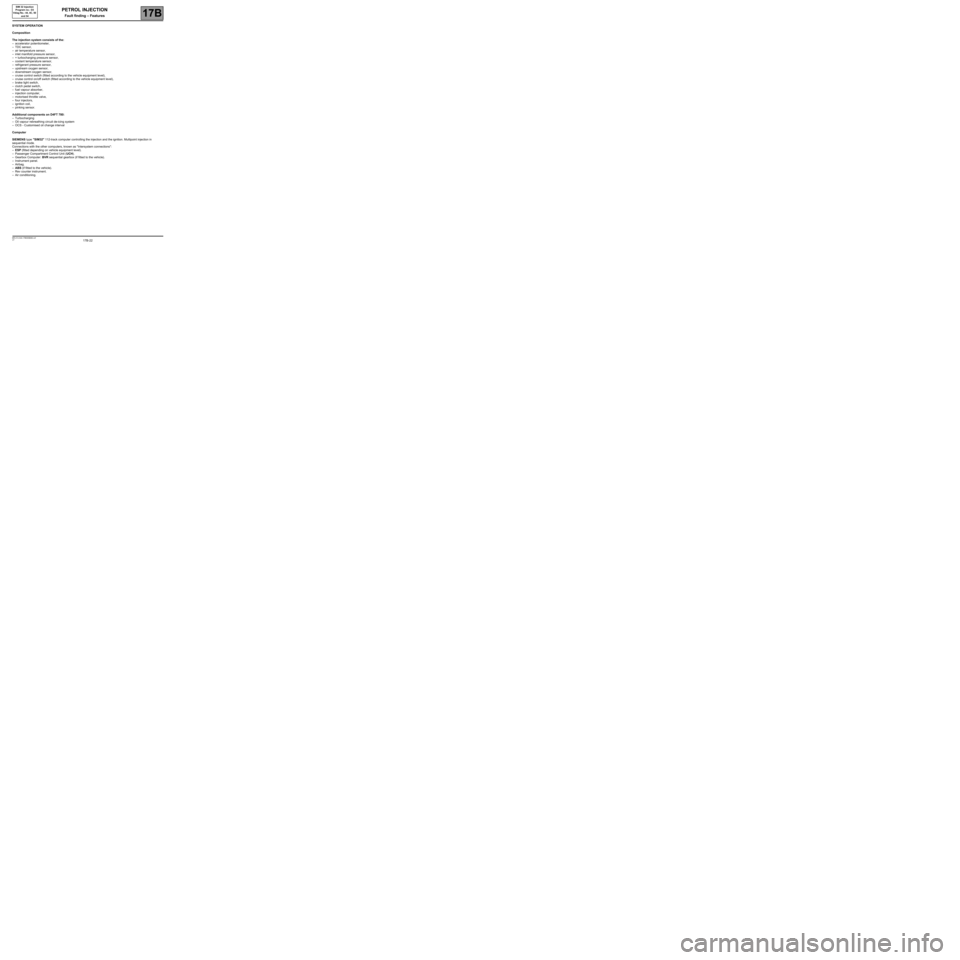2009 RENAULT TWINGO RS fuel pressure
[x] Cancel search: fuel pressurePage 8 of 348

17B-8V7 MR-413-X44-17B000$020.mif
17B
SIM 32 Injection
Program no.: D3
Vdiag No.: 44, 4C, 50
and 54
Precautions/Risks
The precaution related to using the injection system concerns the pedal/motorised throttle valve assembly.
In fact, if the throttle valve stops and the pedal no load limits have not been programmed in the injection computer, the
vehicle must not be driven. Likewise, reprogramming must be carried out whenever one of these parts is replaced.
Risks relating to contamination
All After-Sales operations must be performed under very clean conditions. This means that no impurities should
have entered the system during dismantling.
What are the sources of contamination?
–metal or plastic swarf,
–paint,
–fibres:
–from cardboard,
–from brushes,
–from paper,
–from clothing,
–from cloths,
–foreign bodies such as hair,
–the ambient atmosphere,
–etc.
Advice to be followed before any operation
Check that you have hermetically resealable plastic bags for storing removed parts. Parts stored in this way will be
less susceptible to the risk of contamination. The bags are to be used once only, and discarded after use.
Use lint-free cleaning cloths (cloth part reference 77 11 211 707). Using normal cloth or paper is prohibited. They are
not lint-free and could contaminate the fuel circuit. A lint-free cloth should only be used once.
Use fresh cleaning agent for each operation (used cleaning agent is contaminated). Pour it into a clean receptacle.
For each operation, use a clean brush in good condition (the brush must not shed its bristles).
Use a brush and cleaning agent to clean the unions to be opened.
Blow compressed air over the cleaned parts (tools, workbench, the parts, unions and injection system zones). Check
that no bristles are left.
Wash your hands before and during the operation if necessary.
When wearing leather protective gloves cover them with latex gloves to prevent contamination.
Instructions to be followed during the operationIMPORTANT:
Cleaning the engine using a high pressure washer is prohibited because of the risk of damaging connections.
In addition, moisture may collect in the connectors and create faults in the electrical connections.
PETROL INJECTION
Fault finding – Cleanliness guidelines
Page 10 of 348

17B-10V7 MR-413-X44-17B000$030.mif
17B
SIM 32 Injection
Program no.: D3
Vdiag No.: 44, 4C, 50
and 54
1. SYSTEM OPERATION
Composition
The injection system consists of the:
–accelerator potentiometer,
–TDC sensor,
–atmospheric pressure sensor,
–air temperature sensor,
–coolant temperature sensor,
–refrigerant pressure sensor,
–upstream oxygen sensor,
–downstream oxygen sensor,
–cruise control switch (fitted according to the vehicle equipment level),
–cruise control on/off switch (fitted according to the vehicle equipment level),
–brake light switch,
–clutch pedal switch,
–fuel vapour absorber,
–injection computer,
–motorised throttle valve,
–four injectors,
–pinking sensor,
–4 injectors,
–ignition coil,
–pinking sensor.
Additional components on D4F 764:
–camshaft dephaser,
–camshaft position sensor,
–electrically controlled coolant thermostat.
Additional components on D4F 784:
–Turbocharging system,
–turbocharger,
–Oil vapour rebreathing circuit,
–OCS - Configured oil service interval.
Computer
SIEMENSSIM32type112-track co mputer controlling the injection a nd ignition. M ultipoint injection in se quential mode.
Connections with the other computers, known as "Intersystem connections":
–ESP (fitted according to the vehicle equipment level).
–Passenger Compartment Control Unit (UCH).
–Gearbox Computer: sequential gearbox or automatic gearbox (if fitted to the vehicle).
–Instrument panel.
–Radio navigation (if fitted to the vehicle).
–Airbag.
–ABS (if fitted to the vehicle).
–Protection and Switching Unit (UPC).
–Air conditioning.
PETROL INJECTION
Fault finding – System operation
Page 11 of 348

17B-11V7 MR-413-X44-17B000$030.mif
PETROL INJECTION
Fault finding – System operation17B
SIM 32 Injection
Program no.: D3
Vdiag No.: 44, 4C, 50
and 54
Engine immobiliser
The SIM 32 computer manages an engine immobiliser program:
–The Verlog 4 type immobiliser function is managed by the UCH computer and the engine management computer.
Before any customer request, the engine management computer and UCH exchange authentication frames via the
multiplex network to determine whether or not to start the engine.
After more than five consecutive failed authentication attempts, the engine management computer goes into
protection (antiscanning) mode and no longer tries to authenticate the UCH. It only leaves this mode when the
following sequence of operations is carried out:
–the ignition is left on for at least 60 seconds,
–the signal is cut off,
–the injection computer self-supply cuts out when it should (the time varies according to engine temperature).
After this, only one authentication attempt is allowed. If this fails again, repeat the sequence of operations described
above.
If the engine management computer still fails to unlock, contact the Techline.
Impact detected
If an impacthas been stored by the injection computer (ET077 Impactdetected), switch off the ignition for10 seconds,
thenswitch it back on so that the e ngine can b e started. Then clear the faults using commandRZ0 01 Fault memory.
Fuel supply
Fuel is supplied by the fuel pump. It is controlled each time the ignition is switched on, for 1 second, to provide a
certain pressure level in the circuit, and thereby achieve correct engine starting, particularly if the vehicle has not
been used for a long time. When the engine is running, the fuel pump relay is always controlled.
Injection
The injectors are controlled according to several modes. The engine is started in "semi-full group" mode (injectors
1 and 4, then injectors 2 and 3 simultaneously). This is to ensure correct engine starting whether or not it is correctly
phased, then it enters sequential mode.
It can sometimes, though rarely, happen that the engine starts when incorrectly phased. Then, after it has changed
to sequential injection mode and as long as the cylinder 1 recognition program has not taken place, the injectors are
offset by two cylinders: injection occurs in 4-2-1-3 order instead of the expected 1-3-4-2.
Injection timing is continuously calculated. It can be zero in the event of cut-off whilst decelerating or overrevving for
example.
Engine phasing
SIM 32 D4F 764 injection systems are equipped with a delayed continuous inlet camshaft dephaser.
The injection receives the position of the camshaft dephaser given by the camshaft sensor signal.
This position does not recognise whether the camshaft dephaser is in defect mode or not.
There are two types of defect mode associated with the various types of camshaft dephaser faults:
Page 16 of 348

17B-16V7 MR-413-X44-17B000$030.mif
PETROL INJECTION
Fault finding – System operation17B
SIM 32 Injection
Program no.: D3
Vdiag No.: 44, 4C, 50
and 54
–DF089 Inlet manifold pressure sensor fault 1.DEF: Signal inconsistency.
Or 2. DEF: Open circuit or short circuit.
Or 3. DEF: Non-compliance with emission control standards.
–DF091 Vehicle speed signal in 1.DEF: No multiplex signals or invalid values.
Or 2. DEF: Non-compliance with emission control standards.
–DF001 Coolant temperature sensor circuit in 1.DEF: Signal inconsistency.
Or 2. DEF: Open circuit or short circuit.
Or 3. DEF: Non-compliance with emission control standards.
–DF002 Air temperature circuit in 1. DEF: Open circuit or short circuit.
Or 2. DEF: Non-compliance with emission control standards.
–DF330 Pinking sensor circuit in 1.DEF: Open circuit or short circuit.
Or 2. DEF: Non-compliance with emission control standards.
–DF893 Controlled coolant thermostat circuit in CO: Open circuit.
Or CC.0: Short circuit to earth.
Or CC.1: Short circuit to + 12 volts.
Or 1. DEF: Non-compliance with emission control standards.
Engine torque limitation is activated.
If the fault is directly linked to the controlled thermostat (DF893 Controlled coolant thermostat circuit), the
thermostat is no longer controlled. It operates continuously, either in low temperature mode (instance of short circuit to
earth) or in high temperature mode (instance of open circuit or short circuit to the battery). The engine torque is limited
to limit heating and also to protect the engine by preventing overheating.
c. Functions affected by the presence of a controlled thermostat:
–Coolant temperature: 108˚C nominal, between 70˚C and 90˚C in defect mode or on loaded points.
–Coolant temperature fault finding: the fault finding setting for coolant temperature consistency has been adapted.
–Consumption: The function improves fuel consumption. Consequence: a fault with the function may lead to
inefficient consumption.
–Bleeding the circuit: A new procedure adapted to this innovation is described in MR 392 and 385, Mechanical
systems, CLIO III and MODUS, 19A Cooling, Cooling circuit: Bleeding.
–Coolant temperature display and illumination of the warning light on the instrument panel: During nominal
operation there is no impact as the temperature reference value is taken into account as well as the warning light
illumination thresholds. In the event of malfunction, see the summary table below.
–Fan unit and air conditioning: the fan unit activation threshold and the high temperature air conditioning
deactivation threshold are adapted in accordance with the temperature setpoint.
–Fault finding of controlled thermostat: Electrical fault finding is used. No operational fault finding:
A mechanical fault (such as jamming) will not be detected by the system.
–Performance: In the event of a fault, there is the option to switch the engine to reduced performance mode (see
Description of operation: Operation in defect mode). Note:
If a fault on the coolant temperature sensor is detected, fan assembly 1 is requested to operate permanently,
regardless of the management mode of the engine coolant temperature.
Page 19 of 348

17B-19V7 MR-413-X44-17B000$040.mif
17B
SIM 32 Injection
Program no.: D3
Vdiag No.: 44, 4C, 50
and 54
Injection computer:
This is located on the right-hand side of the engine compartment on the battery mounting.
Fuel vapour recirculation solenoid valve:
This is located on the left-hand side of the engine compartment, behind the engine mounting.
Upstream oxygen sensor:
This is located on the exhaust pipe, downstream of the turbocharger.
Downstream oxygen sensor:
This is located on the exhaust pipe, upstream of the catalytic converter.
Pinking sensor:
The sensor is located underneath the inlet manifold behind the oil dipstick.
Oil pressure sensor:
This is located under the exhaust manifold to the left of the engine compartment.
Turbocharger:
The turbocharger is located after the exhaust manifold.
Turbocharger pressure sensor:
The turbocharger pressure sensor is fitted to the air circuit between the turbocharger and the motorised throttle
valve.
Ignition coil:
This is located on the right-hand side of the rocker cover.
Motorised throttle valve:
The damper valve is located to the right of the inlet manifold.
TDC sensor:
This sensor is located on the flywheel.
Refrigerant pressure sensor:
This sensor is located on the coolant circuit.
Engine coolant temperature sensor:
This sensor is located on the cylinder head near the engine thermostat housing.
PETROL INJECTION
Fault finding – List and location of components
Page 21 of 348

17B-21V7 MR-413-X44-17B000$050.mif
17B
SIM 32 Injection
Program no.: D3
Vdiag No.: 44, 4C, 50
and 54
RV* / LV*: Cruise control/Speed Limiter1 - Injection computer 16 - Upstream sensor signal
2 - RV* / LV* buttons 17 - Ignition command
3 - Multiplex network 18 - Bleed canister command
4 - Turbocharger 19 - Fuel pump command
5 - Motorised throttle 20 - Downstream sensor signal
6 - Manifold pressure 21 - ESP computer
7 - Injector command 22 - Rev counter computer
8 - Clutch Pedal 23 - ABS computer
9 - Brake pedal 24 - Instrument panel computer
10 - Accelerator pedal 25 - Sequential gearbox computer
11 - Refrigerant fluid pressure 26 - AIRBAG computer
12 - Air conditioning compressor command 27 - Vehicle speed sensor computer
13 - Engine cooling fan assembly command 28 - Air conditioning computer
14 - Flywheel signal 29 - UCH computer
15 - Pinking signal 30 – Turbocharging pressure
PETROL INJECTION
Fault finding – Functional diagram
Page 22 of 348

17B-22V7 MR-413-X44-17B000$060.mif
17B
SIM 32 Injection
Program no.: D3
Vdiag No.: 44, 4C, 50
and 54
SYSTEM OPERATION
Composition
The injection system consists of the:
–accelerator potentiometer,
–TDC sensor,
–air temperature sensor,
–inlet manifold pressure sensor,
–+ turbocharging pressure sensor,
–coolant temperature sensor,
–refrigerant pressure sensor,
–upstream oxygen sensor,
–downstream oxygen sensor,
–cruise control switch (fitted according to the vehicle equipment level),
–cruise control on/off switch (fitted according to the vehicle equipment level),
–brake light switch,
–clutch pedal switch,
–fuel vapour absorber,
–injection computer,
–motorised throttle valve,
–four injectors,
–ignition coil,
–pinking sensor.
Additional components on D4FT 780:
–Turbocharging
–Oil vapour rebreathing circuit de-icing system
–OCS - Customised oil change interval
Computer
SIEMENS type "SIM32" 112-track computer controlling the injection and the ignition. Multipoint injection in
sequential mode.
Connections with the other computers, known as "Intersystem connections":
–ESP (fitted depending on vehicle equipment level).
–Passenger Compartment Control Unit (UCH).
–Gearbox Computer: BVR sequential gearbox (if fitted to the vehicle).
–Instrument panel.
–Airbag.
–ABS (if fitted to the vehicle).
–Rev counter instrument.
–Air conditioning.
PETROL INJECTION
Fault finding – Features
Page 23 of 348

17B-23V7 MR-413-X44-17B000$060.mif
PETROL INJECTION
Fault finding – Features17B
SIM 32 Injection
Program no.: D3
Vdiag No.: 44, 4C, 50
and 54
Engine immobiliser
The SIM 32 computer manages an engine immobiliser program:
–The Verlog 4 type immobiliser function is managed by the UCH computer and the engine management computer.
Before any customer request, the engine management computer and UCH exchange authentication frames via the
multiplex network to determine whether or not to start the engine.
After more than five consecutive failed authentication attempts, the engine management computer goes into
protection (antiscanning) mode and no longer tries to authenticate the UCH. The engine management computer only
exits this mode if the following sequence of operations is respected:
–the ignition is left on for at least 60 seconds,
–the signal is cut off,
–the injection computer self-feed deactivates when it should (the time varies according to engine coolant
temperature.
Following this sequence of operations, a single authentication attempt is authorised. If this fails again, repeat the
sequence of operations described above.
If the engine management computer still fails to unlock, contact the Techline.
Impact detected
If an impact has been stored by the injection computer (ET077 Impact detected), switch off the ignition for
10 seconds, then switch it back on so that the engine can be started. Then clear the faults using command RZ001
Fault memory.
Fuel supply
Fuel is supplied by the fuel pump. It is controlled each time the ignition is switched on, for 1 second, to provide a
certain pressure level in the circuit, and thereby achieve correct engine starting, particularly if the vehicle has not
been used for a long time. When the engine is running, the fuel pump relay is always controlled.
Injection
The injectors are controlled according to several modes. In particular, the engine is started in semi-full group mode
(injectors 1 and 4, then injectors 2 and 3 simultaneously), to ensure a correct start whether or not it is correctly
phased, then it enters sequential mode.
It can sometimes, though rarely, happen that the engine starts when incorrectly phased.
Then, after it has changed to sequential injection mode and as long as the cylinder 1 recognition program has not
taken place, the injectors are offset by two cylinders: injection occurs in the order 4-2-1-3 instead of the expected
order 1-3-4-2.
Injection timing is continuously calculated. It can be zero in the event of cut-off whilst decelerating or overrevving for
example.